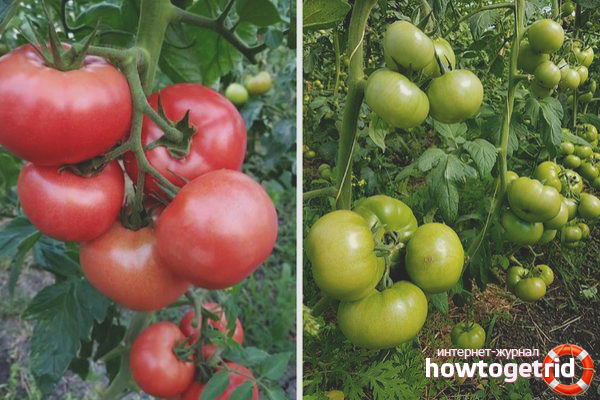The content of the article
This hybrid is bred by Italian breeders. However, relatively quickly, he became popular in Russia. The meaning of its breeding was to combine excellent taste with high productivity.
Grade Benefits
Advantages of the hybrid are:
- high productivity;
- intense original taste;
- early ripening of fruits;
- hereditary immunity to many diseases;
- resistance to high and low temperatures;
- high content of vitamins.
Specifications
The stems are tall, the bushes can reach a height of 2 meters. By the nature of growth indeterminate. By ripening, early ripening. The fruits are rounded in shape, but have a plane. The pulp is dense, painted in raspberry color. From 5 to 8 fruits are formed in each brush. Each of them pulls in weight by 250-270 grams. If you normalize the number of fruits, then their mass can reach 300 grams. Due to their high density, they can be stored and transported over long distances for a long time. In addition, the fruits are resistant to cracking during storage. In heated greenhouses with high agricultural technology, you can get up to 25 kg per square meter. m
Agricultural technology
Before sowing, seeds can be soaked for 12 hours to accelerate germination in a solution of a stimulating drug. However, if the seeds are full-weighted, then the procedure is optional. When sowing, it is advisable to close them by 1.5 cm. After sowing, it is recommended to place the container with crops in a plastic bag or cover with glass for the period of germination and place in a warm place.
After the seeds have sprouted, the film or glass should be removed, and if possible should be transferred to a cool place for 5 days. After two real leaves have grown, seedlings must be peaked - planted in separate cups. With weak growth, it is advisable to feed the seedlings with nitrogen-containing fertilizer. As extracts from vermicompost, as well as some mineral compositions, such as potassium nitrate, Aquarin, are suitable. To accelerate the development, you can use some biological products (Baikal EM1, Vostok EM1), or special stimulants (Zircon, Silk, Narcissus).
A few days before transplanting, it is recommended to harden it - take it out for 2-4 hours in the open air. Immediately before disembarkation, it is useful to spray the solution of Ecoberin in the evening to prevent sunburn. It enhances the production of protective substances in the skin.
Before planting, some agronomists recommend introducing humus and ash with superphosphate throughout the entire bed. With a deficit of fertilizers, you can limit yourself to adding them to the wells. Biohumus, WMD, AVA-universal 1 year are also suitable as a fertilizer. Between plants in a row should be left 35-40 cm.
Post-landing care

After the plants are planted at the place of fruiting, tomato plants need to be watered, and it is advisable to mulch with mowed grass or peat or other loose organic matter. As the plants grow, they should be tied to trellises.
Bushes of this hybrid develop a powerful root system, so less than other varieties and hybrids depend on watering. However, you still need to check the soil moisture. In hot weather, soils, primarily light in terms of mechanical composition (sandy, sandy loam), still have to be watered, especially if there is no mulch.
Top dressing
Before the third flower brush blooms, agronomists recommend avoiding top dressing with nitrogen-containing fertilizers to prevent the fatliquoring of bushes. But from the moment of its blooming, top dressing with organic (Gumidar, Gumistar) or complex mineral fertilizers, such as Zdraven, Mortar, is recommended. As organics, you can also use infusions of herbs, such as nettle, dandelion.
Formation
Plants must be formed into one stem, removing all stepsons. Lower leaves to the flower brush are also recommended to be removed.
Plant protection
Tomato plants can be affected by several diseases and damaged by certain pests. Of infectious diseases, in addition to the well-known late blight, they are also affected by cladosporiosis, macrosporiosis, black spotting. Cladosporiosis appears as a brown coating on the underside of the leaves. Macrosporiosis can be recognized by spots with concentric circles. To prevent these diseases, it is advisable to spray healthy plants with immunity inducers (immunocytophytes, Humates, Narcissus, homeopathic medicines), biofungicides (Alirin-B, Bactofit) in preventive concentrations. I recommend combating black bacterial spotting with the help of the biological product Gamair.
Video: how often and how much to water tomatoes?










Submit